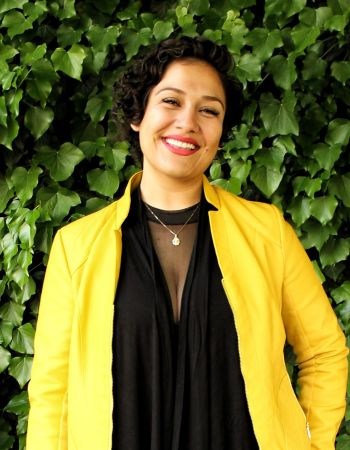
By Kate Wallace
Alejandra Ramírez’s words of advice spark hope: “Believe in what you feel. Follow that feeling of joy and pleasure and what excites you.” Ultimately, you’ll see your dreams come true. That spark led Alejandra to a career – really, a calling for her life’s work – that she never knew she needed.

But her story doesn’t start like you’d expect. Alejandra dropped out of high school in 9th grade. When she talks about the path her life took, she says that she did the life stuff first, then dived into education. She got married and had a couple kids, got divorced, and then decided she wanted to finish her high school education.
At 23 years old, she went back to get her high school diploma through adult education, got the college bug, and hasn’t stopped since. Now? She’s teaching college classes at the University of Texas Rio Grande Valley.
“I have this real-world experience already that has shaped who I am and what kind of educator I am,” she says. “I think it’s why I get along so well with students.”
Telling her story to her students is important to their support, just like the support she got at SCTCC when she was a student here. Alejandra remembers Abraham Hernandez, a recruiter who reached out to her to organize a Latino Club on campus.
“I developed so many good friends [at SCTCC], that I was friends with them all through undergrad,” she points out. The Latino Club was different from the other clubs on campus, which were organized around classes. With this club, she was able to get support from others, which helped her have another reason to “stick around, other than education.”
SCTCC was more approachable in many ways. St. Cloud State was daunting to her and she didn’t think she was “smart enough” to go there. Plus, SCTCC was near her mom’s house: just a couple blocks away. The closeness of her fellow students, the support of the Latino Club, and instructors’ involvement were vital to her time at SCTCC, and she knew she was in the right spot.
Alejandra graduated from SCTCC with an AA, then she transferred to SCSU to get a bachelor’s degree in English and a minor in communication studies.
“What the heck am I gonna do with an English degree?” she recalls herself thinking.
But after going to a NACCS (National Association for Chicana and Chicano Studies) national conference, where she was immersed in academia, and with the guidance of instructors at SCTCC and SCSU, Alejandra realized she wanted to go down the path of higher education and teach. She was following what brought her that feeling of joy, and she was determined to make it happen no matter the obstacles.
She was accepted to the University of Arizona for her graduate studies, so Alejandra had a yard sale, and with the $350 she made, she packed up her car with her two kids, her cat, and two birds, and she moved her family to Arizona. With the support of a mentor, they managed to pay the first month’s rent, but still slept on the floor until her first paycheck came through. It’s now eight years later, she’s graduated and has become an award-winning artist and scholar.
While her Ph.D. is in Rhetoric and Composition (with a minor in Mexican American Studies), what really makes Alejandra’s dissertation research stand out is the methodology she used. She began by looking at global borders and systems associated with political boundaries, and then examined the art and aesthetics that are present at these locations. Approaching these presentations of art with a holistic and embodied view when it comes to research methods is challenging but something she loves. Developing the method to be able to use art in research and publishing it humanizes the research.

Traditional research methods (empirical research) are black and white a lot of the time, looking at numbers or specific survey questions. But the research method that Alejandra used is something that embraces more cultures and more ways of thinking. It can also encompass more of the human story by involving items that aren’t usually a part of research, like art or storytelling. Many artists, writers, and scholars have valuable contributions but aren’t respected at the same level because they aren’t able to or don’t want to present in the same scholarly fashion. She says it’s like looking through a nest of serpents, and she calls it facultades serpentinas, or serpentine Intuition––a methodology rooted in Chicana and Mexicana-Indigena knowledge.
“There are a lot of ways that academia fails the very thing they say they’re researching – storytelling, and the rights of Indigenous peoples. Yet they don’t value it as a methodology when it comes down to it because it doesn’t follow the same framework,” Alejandra explains. By prioritizing empirical research, we lose a lot of the human experience. But we can make room for other types of research and shift to the idea that sometimes the sensation and the feelings are the priority.
It's this type of non-traditional, forward thinking that has made her reach toward her dreams and focus on what brings her joy. Following her heart got to where she is today, a professor on a tenure track at the University of Texas Rio Grande Valley. She works primarily with Latino and Mexican-America students, who she has connected with the same way the Latino club advisor at SCTCC, Abraham, connected with her. By sharing her personal journey with her students, she’s able to allow them to be themselves and embrace their lives as well as their education: “I’m always mindful that students are parents or they have jobs, or they’re nontraditional. I try to hold my own expectations to myself.”
Now that’s she’s teaching, that doesn’t mean that Alejandra has stopped reaching for bigger goals. She’s continuing to make things happen by making connections with the city and county and has set up an LLC for Serpentine Intuition. She wants to create spaces and classrooms in and outside of academia to help others show up to share diverse ways that culture, race, bodies, hearts, and needs may manifest in people’s lives. For now, she’s especially focused on young, migrant women’s rights and literacies.
Alejandra’s journey is serpentine in itself, twisting in ways that you wouldn’t expect. But she’s also focused on smashing the traditional model and elevating people whose passions and work may be unexpected.
“Follow that feeling of joy and pleasure and what excites you. Hold onto it, have faith in it,” she says with a sparkle in her eyes. “You might not understand it until much, much later. This is always what I wanted to do and I didn’t realize it.”
The header image is licensed under the Creative Commons Attribution 3.0 Unported license.